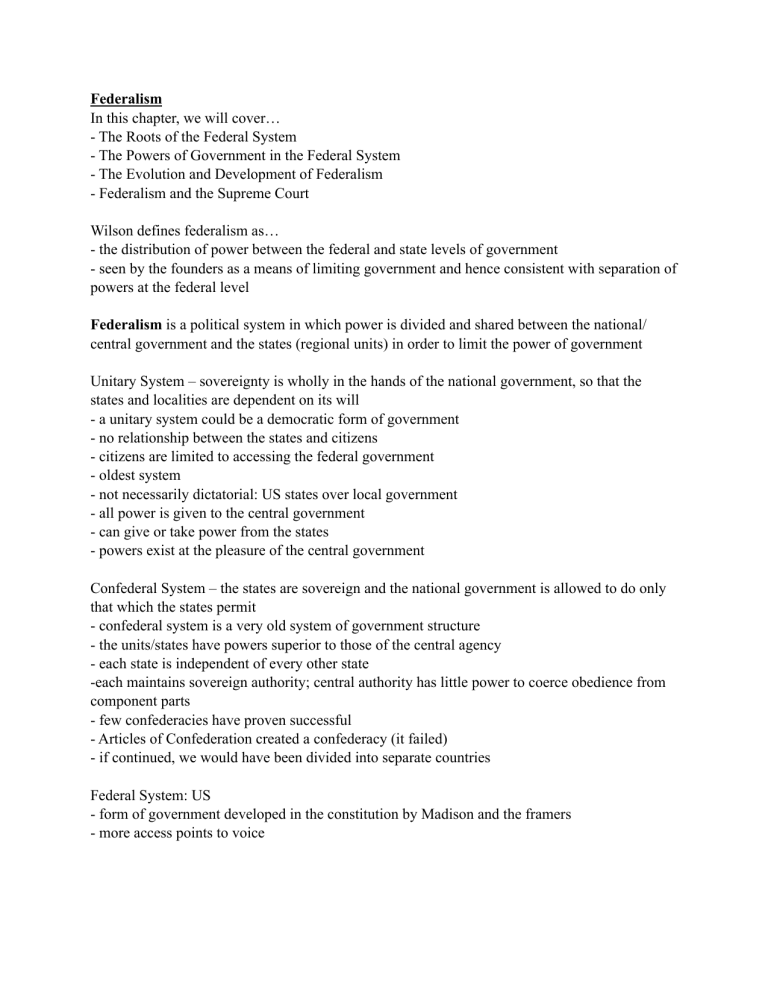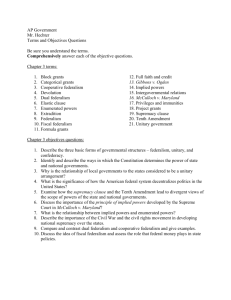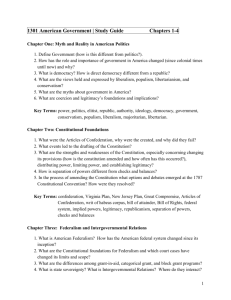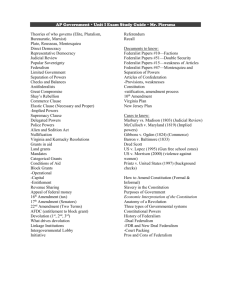Federalism In this chapter, we will cover…

Federalism
In this chapter, we will cover…
- The Roots of the Federal System
- The Powers of Government in the Federal System
- The Evolution and Development of Federalism
- Federalism and the Supreme Court
Wilson defines federalism as…
- the distribution of power between the federal and state levels of government
- seen by the founders as a means of limiting government and hence consistent with separation of powers at the federal level
Federalism is a political system in which power is divided and shared between the national/ central government and the states (regional units) in order to limit the power of government
Unitary System – sovereignty is wholly in the hands of the national government, so that the states and localities are dependent on its will
- a unitary system could be a democratic form of government
- no relationship between the states and citizens
- citizens are limited to accessing the federal government
- oldest system
- not necessarily dictatorial: US states over local government
- all power is given to the central government
- can give or take power from the states
- powers exist at the pleasure of the central government
Confederal System – the states are sovereign and the national government is allowed to do only that which the states permit
- confederal system is a very old system of government structure
- the units/states have powers superior to those of the central agency
- each state is independent of every other state
-each maintains sovereign authority; central authority has little power to coerce obedience from component parts
- few confederacies have proven successful
- Articles of Confederation created a confederacy (it failed)
- if continued, we would have been divided into separate countries
Federal System: US
- form of government developed in the constitution by Madison and the framers
- more access points to voice
- central government must be made stronger (because of Shay’s Rebellion and fear of foreign invasion), but not too strong
- separation of powers and federalism do this
- under a federal system, unlike others, neither the state nor the central government has the power to destroy the other (don’t serve at the pleasure of one another)
- independent authority derived from the constitution despite cases like Wickard, states have lots of power and authority
Compared to Confederacy: in federal system the central authority is created by and owes its legitimacy directly to the people (i.e. the central government draws its legitimacy directly form the people not from the states)
Compared to Unitary: In federal system, constitutional authority is distributed between two levels of government
- powers may not be equal but equal in the right to exist; both draw legitimacy from the people
- the states cannot dissolve the union nor can the union dissolve the states
- states, local government, and federal government require legitimacy
- if they are acting up, will hear from the people
Powers Indicative of Federal System
Exclusive Powers – powers belonging only to one level of government (e.g. only the federal government can declare war; states retain power over education; local government on most police matters)
Concurrent Powers – areas of authority shared by both levels of government (e.g. both have the power to levy taxes)
Power Conflicts
- where there is a conflict in an area of the exercise of concurrent powers, the supremacy clause of the constitution gives the upper hand to the national government
The framers worked to create a political system that was halfway between the failed confederation of the Articles of Confederation and the tyrannical unitary system of Great Britain.
Why Federalism?
The three major arguments for federalism are:
1) the prevention of tyranny and promotion of limited government
2) increased participation in politics through multiple access points
3) pre-existence of the states
Powers of Government in the Federal System
The distribution of powers in the federal system consists of several parts:
- exclusive powers (belong to each alone)
- denied powers (denied to one)
- enumerated powers (listed out)
- implied powers (necessary and proper)
Relationships within Federal Structure
- horizontal federalism: relationships among the states
- Constitution: 3 clauses deal with horizontal federalism:
- extradition: if criminal crosses states lines, return him/her
- full faith and credit: if you are married, cross state lines, still married
- privileges and immunities
- constitutionally mandated procedure to get states to recognize the nation
- there to recognize sovereignty but encourage the nation we are
- vertical federalism: more commonly thought of as federalism: relationship between states and central government
- distribution of power between two levels is complex and has been fluid federalism has a dynamic relationship
- it has not been static but rather has been a constantly revised relationship between the states and the federal government
Dual Federalism 1789-1860
- national government is one of enumerated powers only
- within their respective their spheres are sovereign and equal
- the relationship between two centers of power is one of equality
- national view (federalists) vs. state-centered view (anti-federalists)
- after the civil war, the states end up with less, permanently
- if we hadn’t fought the war, this dual federalism would have maintained itself
Dual Federalism with a Difference 1861-1930
- major financial shift away from tariffs and land sales to income taxes
- gave the federal government the most lucrative source of tax revenues (amendment passed in
1913)
- by 1927 income tax constituted 60% of the total federal revenues
- income tax allows size and scope of federal government to grow
- revenue creates giant federal infrastructure inclined to save our economy
Rise of Cooperative Federalism 1930-1960
Great Depression brought a rapid decline to dual federalism and the rise of Cooperative
Federalism:
- federal system characterized by a sharing among federal/state/local of virtually all functions
- it is impossible to divide the functions between federal state and local government
- federal state and local affairs are not adversaries, they are colleagues
- the American Government is best conceived as one government serving the people
- this period witnessed an enormous increase in the federal government’s participation with the states in public finances and in programs
- New Deal resulted in landmark expansion of federal taxing and regulatory power over the economy to include the sale of securities, public utility regulation, agricultural production and marketing, labor relations (wage and hour)
- the economy in all of its key areas had become a federal topic
Growth in All Government
- states too became more active and more important
- police powers of states actually expanded and states became implementers of federal programs
- (police powers – state power to enact laws promoting health, safety, and morals)
What Changed in the 1960s?
- rise of cooptive federalism (1960-1980)
- feds used leverage to force controversial programs on states
- national government established national goals and pressured, even coerced, the states to frequently reluctantly accept
- use the power of the purse to force state compliance or take-over state’s existing role in the matter
Cooptive Federalism
- through categorical grants: usually federal government to local government (bypassed the states)
- e.g. under LBJ over 200 new grant programs were enacted (civil rights, aid to poor, environmental concerns, drug abuse)
Grants in Aid
- have been around since founding (land grants, etc.)
- however, their proliferation and how they are used by the feds (for what purpose) is the issue; if you take money must pay a certain wage, affirmative action, etc.
- until 1960s the grants used cooperatively with states
- after the 1960s, the money was used to accomplish national goals, not state goals
- e.g. healthcare grants soar while transportation grants dwindle
- between 1960 and 1980 federal government expands scope of bureaucratic growth in response to many social programs (great society)
- many states didn’t agree with that, most from the south
Current System 1980-present
- Ronald Reagan’s inaugural address spoke of government as the problem, not the solution
- conservative mood building over cooptive politices (many of whose intersts are not voiced politically (the poor))
A Look to Less Government
- begun with revenue-sharing programs under Nixon, but really increases under Reagan and
Clinton
How: big focus on block grants
Block Grants
- Federal deficits and tax policy, esp. in 1986, really cut spending off for programs that increased federal authority over states
- states and local governments get a block of money that’s less but fewer strings attached on how to spend the money (more state autonomy)
- grant and aid different than a block grant
- federal government can tell you how to spend grant and aid money
- more strings attached
- if states don’t spend it properly, give money to local government
- if you won’t integrate schools, not giving you federal money
- how the federal government decides to fund things is important
- a block grant has no strings attached, more power for states
- use it however you want (less money though)
Devolution to States
- cut in federal budget, but now states had to provide services
- additionally, rise of unfunded mandates: state required to pay for healthcare for children or no child left behind, but without federal money
- all of a sudden grants look better
Why do they have to provide the services?
- because the American public expects it!
- when too much is localized and power given to the states, some problems become untenable: what about FEMA or FDA or EPA
- if states have to clean up after their own disasters, monitor their own food safety, their own environments, what does this mean?








